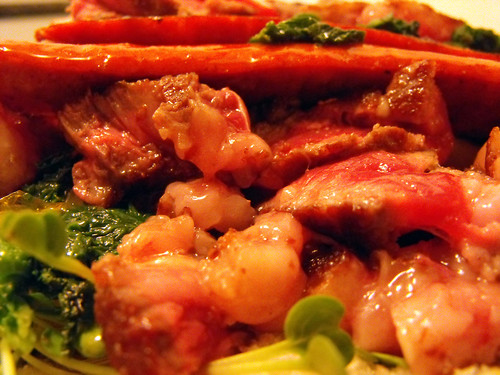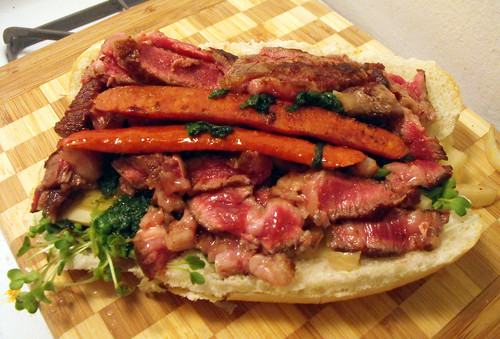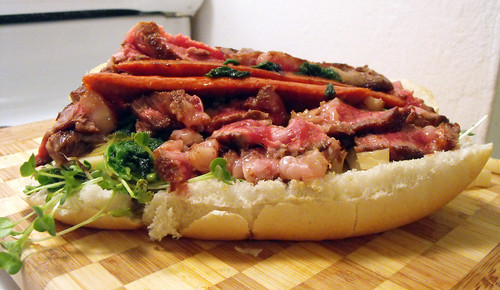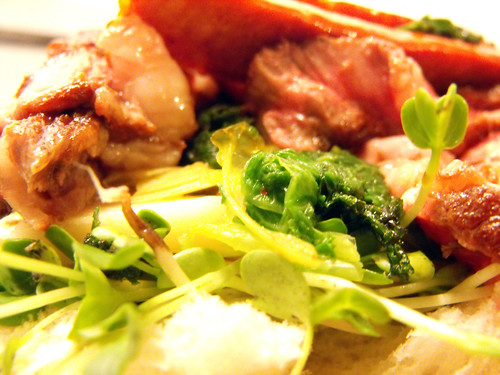I'm not going to tell you how to cook anything sous-vide.
You can deep fry without a deep fryer. You can roast coffee without any tools designed for roasting coffee. You can make pizza without a pizza stone. But there is a hard limit on how seriously you can approach sous-vide cooking without dedicated, specialized equipment, and even the "low end" versions of that equipment is either something you have to build at home, or sells for a few hundred dollars - more expensive than anything in my kitchen except the refrigerator, oven, and dishwasher. I don't have that equipment, so I can't even tell you how to use it if you do. I am not the guy for this. Do not come to me for sous-vide.
Most food safety guidelines are horseshit.
Sometimes the idea is to protect the producer - the poultry factory, for instance - from litigation by minimizing the impact of their dangerous practices on the consumer. There's nothing inherently unsafe about raw chicken, and rare to medium-rare chicken is common in most of the rest of the world - but I'm sure as shit not going to eat a raw drumstick from the major American poultry producers. That's a problem with their practices, though, not with chicken itself.
Sometimes the idea is to adopt universal practices that protect a tiny segment of the population. Raw shellfish is a good example. Despite the warnings on all those menus, raw shellfish results in an exceptionally small number of hospitalizations, almost entirely among the immuno-compromised and elderly.
Hamburger cooking regulations are a little from column A and a little from column B. The risk of contamination can be minimized through safe practices, and some jurisdictions have the fairly sensible requirement that you can only serve a rare hamburger if you grind your beef yourself on a daily basis.
A large number of food safety guidelines and squeamish attitudes are just fucking stupid. I mean, I made country ham in my loft - you know I have a low opinion of squeamishness, you know I'm not going to fall in line with the turkey-burning FDA on many issues.
Sous-vide safety guidelines are not horseshit.
I want to make that distinction very clear.
Don't listen to me about sous-vide cooking. Don't use me as your authority. The guys at
Cooking Issues are the ones to listen to. The most I will do is tell you what I've done and affirm that I lived to see another day.
Sous-vide means "under vacuum," but when we refer to sous-vide cooking we're specifically talking about cooking things which have been sealed in a plastic bag and immersed in a low-temperature liquid, typically a water bath, for a long period of time. The specialized equipment is necessary because the liquid is held at a low enough temperature that it's hard to keep it at that temperature. Temperature fluctuations are undesirable in this kind of cooking, and conventional cooking methods are chock full of them. A difference of a couple degrees will totally change the texture of a sous-vide egg, for instance; meat is a little less finicky.
By "low temperature," we mean like 120-150 degrees Fahrenheit, like 48-70 centigrade, a fistful of kelvins. The undersimmer. Far less than boiling, less than you ever cook anything. I've been judging water temperature by how quickly the water starts to smart when I dip my finger in it -
don't do that! For a lot of reasons don't do that. One, because I don't want you to fucking sue me. Two, because I don't know you, I don't know the life of your finger, what you need from it, whether you're a surgeon or some damn thing, I don't need that on my head. Three, because I have no idea how to tell you how to do it, I just know that I can dip my finger in at three in the afternoon, do it again at five, and tell you if it's gotten warmer or cooler. Call it experience, call it half-idiot cooking, just don't do it yourself unless you were already on that page before today. It's terrible science. Ghostbusting nonsense. Don't be ridiculous. Get the special equipment instead.
These sound like insanely low temperatures, right? These sound like temperatures that don't even count as cooking.
That's because we're used to ovens. We're used to 400 degrees. We're used to putting the broiler on to get the son of a bitch hot enough to make a pizza.
When you cook something in an oven, you're cooking in a dry medium, and as moisture on the surface of the food heats up, it evaporates, and the surface is cooled - just like sweating. Evaporative cooling is basic elementary school physics, science with its Keds on and a tooth under the pillow, you know this shit. Air is a terrible thermal conductor. Think about it, you know when you put the thermometer in that roast, that turkey, whatever, it's not fucking 350 degrees. You have to heat the oven much, much, MUCH hotter than the temperature you actually want the food to reach.
With sous vide cooking you don't.
That's what a lot of it comes down to. You put the steak in a plastic bag with a little liquid to help prevent any air from remaining in the bag, you get the air out, you drop the bag in a hot water bath. The water conducts the heat better than air. Eventually the steak reaches the temperature of the water.
It takes a long time. Hours. Days. Literally days, I'm not blowing smoke. In that time, less fat is rendered than in the oven, but more collagen is converted into gelatin. A staggering amount, really.
As it says in that Cooking Issues link, you want to bring the meat up to a hot enough temperature
within the first four hours. To avoid botulism, which you do not want to fuck with. This is one of the strikes against attempting sous-vide without dedicated equipment designed for the task, because simply dropping the meat into the water is going to bring the temperature down, and anything too big is not going to hit the mark in four hours. Do not fucking sous-vide a turkey in your lobster pot, you will ruin everything for everyone.
I cooked turkey wings sous-vide for about 15 hours - again, don't do this without special equipment and knowing what you're doing - with a little butter, Vegemite, and sriracha. Turkey wings have a lot of collagen, and come out too tough if you bake or deep-fry them. You can break a tooth for Christ's sake.
But sous-vide, they were as tender as pulled pork. The juices that rendered out were so rich in gelatin that they were solid at room temperature.
Often you finish a sous-vide dish by searing it or torching it, because this style of cooking, like boiling or steaming, lacks any Maillard reactions. I cooled the wings and then deep-fried them to reheat them and crisp up the outside.
They were ridiculously awesome and I'm going to do it again a million times.
I'm cooking some pigs' feet sous vide. I might take some photos depending on what I decide to do with them, and I made some salsa that I think will go well in a taco. But don't you do it!
















